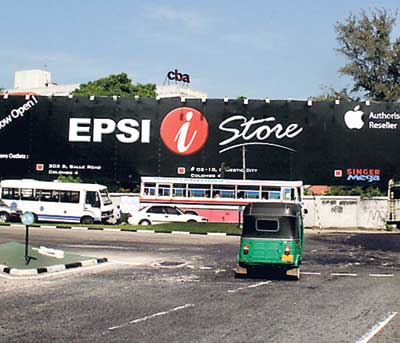
Colombo – Garden City or Billboard Jungle - letter
There was a time when we enjoyed the small forest of huge hand-painted cinema posters at Maradana. It was an ever-changing exhibition of public sketches. If this was a billboard jungle, it was confined to a single street junction in a Colombo which still remained a green city, with an urban core of tree-lined avenues and the rich foliage of house gardens. The most beautiful remaining parts of the former ‘garden city of Asia’ were areas like Cinnamon Gardens and Havelock Town. Although there are plush residential areas, the haunts of the rich, they were also in fact public venues containing institutions like museums, libraries, the BMICH, the university and so on, visited daily by thousands of people from all parts of the country, for whom this green urban landscape was a model, a part of the rich urban heritage of the country’s principal city. The Maradana poster show was an odd dot in this urban landscape. Thirty years later the disease of the billboards has grown beyond our worst expectations. Almost all the tree-lined avenues are now blocked out by huge photo ads, never seriously read by anybody except perhaps when stuck in a security traffic jam. They may be an adman’s dream of strident, high cost promotion but in fact serves little purpose other than disfiguring the landscape. The irony of it is that the billboard jungle – and some would turn the metaphor round and call it the billboard desert – is organised by the Colombo Municipal Council and a major revenue earner for the CMC. Or so we are told. This expression of municipal culture is matched by the CMC’s flagpole hoisting unit whose task is, for a fee, to go around the nicest parts of the city digging up well laid pavements and smashing paving slabs to erect galvanised pipes to which are attached flags and banners heralding some ephemeral event or other. The latest episode in this disfigurement campaign can be seen in the largest ad poster in Colombo, at the Thummulla junction. Advertising an unspecified product referred to only as ‘Epsi’, not only does the poster cut off from view the period architecture of the 100-year old DBU building, with its unique, neo-baroque gable, but the ad men have also cut the branches of a beautiful rare tree that slightly blocked the view of the colossal ad. The tree has now been reduced almost to a stump which is unlikely to survive (unless someone comes to its rescue pretty quickly). The lopping of this tree has a reverse symbolism. It mirrors and shows up the periodic tree-planting rituals that we indulge in – one step forward, two steps back. It epitomises the replacement of an elegant decades-old townscape by unbridled, raucous commercialisation. Consumers, consumer protection groups, Ruk Rakaganno, tree-lovers, conservationists, urban planners, municipal councillors – and ad agencies – take note. To the officials and the ad men we say, please develop some aesthetic sensibilities and civilised standards. But we, the silent majority, on our part must also realise that whatever rules and regulations are enforced or not enforced, only consumer awareness and consumer resistance can eradicate this menace. Perhaps Ruk Rakaganno could publish a listing of the main products that are advertised on these tree-obscuring hoardings, negotiate guidelines with the ad men or recommend consumer boycott of offending advertisers and products. This will surely work.. In the meantime, over to you Chairman UDA and Municipal Commissioner, the permanent guardians of the urban landscape. |
|
||
| || Front
Page | News
| Editorial
| Columns
| Sports
| Plus
| Financial
Times | International
| Mirror
| TV
Times | Funday Times || |
| |
Reproduction of articles permitted when used without any alterations to contents and the source. |
© Copyright
2007 | Wijeya
Newspapers Ltd.Colombo. Sri Lanka. All Rights Reserved. |
